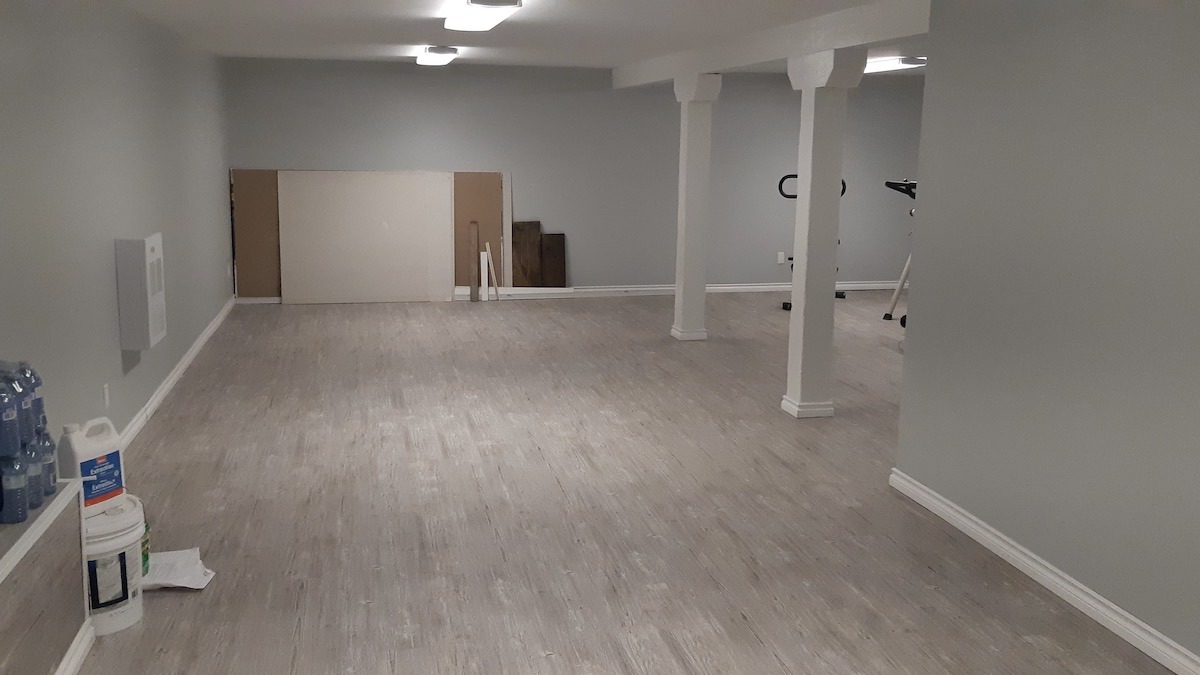
I. Assessment of the Lower Level Space: Current State and Unused Potential
A. Current State of the Space: A Monument to Missed Opportunity
The lower level is aesthetically clean, exceptionally well-lit, and appears structurally sound—a testament to successful remediation efforts.
- Appearance: Freshly painted walls in a neutral tone, new, gleaming laminate flooring, and modern recessed lighting combine to create a contemporary and inviting atmosphere. The successful remediation has not only restored but significantly improved the space’s foundational integrity and visual appeal, rendering it “better than it has ever been” from a physical standpoint.
- Layout: The area is an open, largely empty expanse, punctuated only by visible support pillars. Crucially, the space is currently devoid of any furniture, equipment, or active programming setup. It stands as a pristine, yet empty, shell, waiting for a purpose that has yet to materialize.
B. The Paradox of an Empty, Ready Space: A Monument to Inaction
The LSB’s lower level is aesthetically clean, well-lit, and structurally sound, projecting a professional and welcoming environment. Its open-concept layout offers maximum flexibility. Yet, this “better than ever” space remains stubbornly unused. This isn’t a problem with the facility itself, but rather a direct consequence of the LSB’s operational incapacities and systemic resistance to progress:
- Absence of Defined Purpose & Programming: A Failure of Vision: A truly empty space, regardless of its pristine condition, lacks a clear identity because no one has bothered to give it one. Without specific programs developed, scheduled, and marketed, there is no inherent reason for anyone to use it. This fundamental lack of a clear vision from the LSB is the primary and most damning barrier to its activation. The space isn’t just lacking programs; it’s lacking the most basic strategic thought.
- Severe Resource Constraints (Human & Digital): A Self-Imposed Handicap:
- “Barely Internet” in the Office: A Crippling Digital Pre-Cambrian Era: The LSB office’s severe internet limitations are not merely an inconvenience; they are a foundational, deliberate incapacitation. Operating in a digital vacuum directly hinders any attempt to efficiently plan, promote, register participants for, or even communicate about programs. This isn’t just “barely internet”; it’s an active rejection of modern operational necessities, effectively placing the entire complex in a pre-internet dark age and making capacity building impossible.
- Limited Staff/Volunteer Capacity: An Apathy-Induced Paralysis: Even with an ideal space, the LSB’s pronounced lack of human resources—both staff and dedicated volunteers—is a direct indicator of its organizational apathy. Without individuals committed to conceptualizing, organizing, and delivering programs, the space will predictably remain dormant. The absence of a championing team or even a single dedicated individual to drive its use highlights a profound operational inertia.
- Absence of Equipment/Furnishings: The Obvious Left Undone: While professionally remediated, an empty space remains fundamentally unusable without basic equipment and furnishings. The glaring absence of essential items like tables, chairs, or even rudimentary supplies for specific activities (e.g., yoga mats, art supplies) points to a complete lack of foresight and practical planning. It’s a space prepared for nothing, because nothing has been prepared for it.

II. Incredible Potential: A Vision Squandered by Inaction
The LSB’s lower level represents an extraordinary, untapped resource, perfectly positioned to significantly advance the goals of the Framework for Recreation in Canada. However, its current dormant state means this immense potential is not just unfulfilled, but actively being squandered due to the LSB’s persistent inaction and systemic deficiencies.
A. Goal 1: Active Living – A Barren Landscape
Potential: This open, clean, and well-lit space is ideally suited for various forms of physical recreation. It could effortlessly host vital community programming like fitness classes (yoga, Pilates, aerobics), dance workshops, and even arts exhibitions that encourage active participation. Imagine the health and vitality this could bring.
Current Reality: The space is completely empty, a stark void preventing any active living programming from taking place. This isn’t just a missed opportunity; it’s a failure to meet a fundamental community need for physical well-being.
B. Goal 2: Inclusion and Access – An Empty Promise
Potential: As a professionally remediated, accessible blank canvas, the space offers the profound opportunity to design programs that intentionally dismantle social and economic barriers. This could involve offering low-cost or free programs, activities specifically adapted for individuals with disabilities, and targeted programming for underrepresented community groups, fostering true equity.
Current Reality: The considerable potential for fostering inclusion remains entirely unrealized. With no active programs, no one is currently benefiting from its inherently accessible and welcoming nature. It stands as an accessible space no one can access.
C. Goal 3: Connecting People with Nature – A Disconnected Hub
Potential: While an indoor venue, this space could play a crucial, albeit indirect, role in fostering a connection with nature. It could serve as a vital “base camp” for land-based activities, acting as a meeting and orientation point for guided hikes, snowshoeing excursions, or nature photography workshops. Indoors, it could host educational presentations on local ecology, Indigenous land-based learning, and even feature natural elements in its decor to cultivate environmental appreciation.
Current Reality: Its current unused state means it contributes absolutely nothing to fostering a connection with the local natural environment, leaving a valuable educational and recreational avenue unexplored.
D. Goal 4: Supportive Environments – A Social Void
Potential: This meticulously remediated space inherently offers a physically supportive environment that is safe, clean, and modern. Its open layout is naturally conducive to positive social interaction and robust community building through shared activities. It possesses the raw capacity to become a vibrant social hub where residents feel profoundly connected and supported. Furthermore, its location within the LSB facility offers a socially supportive environment with direct access to community administration and resources.
Current Reality: The empty and silent nature of the space is the antithesis of a supportive environment, failing to build either physical or social connections for community members. It is a place of potential connection that instead perpetuates isolation.
E. Goal 5: Recreation Capacity – A Dormant Asset, Wasted Potential
Potential: This fully remediated space dramatically increases the LSB’s inherent capacity to deliver a wider range of programs and services to the community. It provides a dedicated, high-quality venue that can diversify the community’s recreational, artistic, and cultural offerings. The successful remediation itself demonstrates organizational resilience, a fact that could be leveraged to secure further partnerships and substantial grants for programming.
Current Reality: The dormant status of this significant asset directly contradicts and undermines the goal of building recreation capacity. It represents a profound, missed opportunity to strengthen the community’s recreational infrastructure, leaving valuable resources idle and unutilized.

Unfulfilled Potential: A Blatant Disregard for Community Well-being
The LSB’s lower level, despite its current dormancy, holds immense potential to align with the Framework for Recreation in Canada: Pathways to Wellbeing. However, the existing, self-perpetuated challenges mean this potential is not merely unrealized, but actively neglected and squandered:
- Active Living: A Wasted Opportunity: The space is ideal for fitness classes, dance workshops, and other physical activities. Currently, its emptiness prevents any form of active living programming, leaving a significant, unaddressed community need festering.
- Inclusion and Access: A Promise Unmade: This remediated space could actively remove social and economic barriers through low-cost or accessible programs. Yet, without any active programs, no one is benefiting from its inherently accessible nature; its potential for inclusion is completely squandered.
- Connecting People with Nature: A Non-Existent Role: While an indoor venue, it could serve as a “base camp” for outdoor excursions or host educational presentations. Its current unused state means it contributes absolutely nothing to fostering a connection with the local natural environment.
- Supportive Environments: The Antithesis of Community: The meticulously remediated space could provide a physically supportive environment, a vibrant social hub fostering community connections. Instead, its empty and silent nature is the antithesis of a supportive environment, actively failing to build either physical or social connections for community members.
- Recreation Capacity: A Deliberate Undermining: This fully remediated space should dramatically increase the LSB’s capacity to deliver a wider range of programs. The dormant status of this significant asset directly contradicts and undermines the very goal of building recreation capacity, representing a glaring, missed opportunity to strengthen the community’s recreational infrastructure.
The Path Forward: Confronting a Crisis of Leadership and Competence
Transforming the lower level from a dormant, neglected asset to a thriving community hub necessitates a radical shift in organizational approach and accountability. The primary obstacles are not structural, but lie almost entirely in the complete absence of a defined purpose and programming, severe resource limitations (both human and digital), and the critical lack of essential equipment. These issues are symptoms of a deeper problem: digital illiteracy, weak and ineffective board governance, severe resistance to change, and a total absence of impetus to secure funding or mobilize necessary volunteers.
Until these foundational failures are directly confronted and rectified, the community hall’s lower level will continue to stand as a shameful monument to untapped potential and organizational inertia, rather than a vibrant center for community well-being. The time for activation isn’t merely “now”; it’s long overdue.




